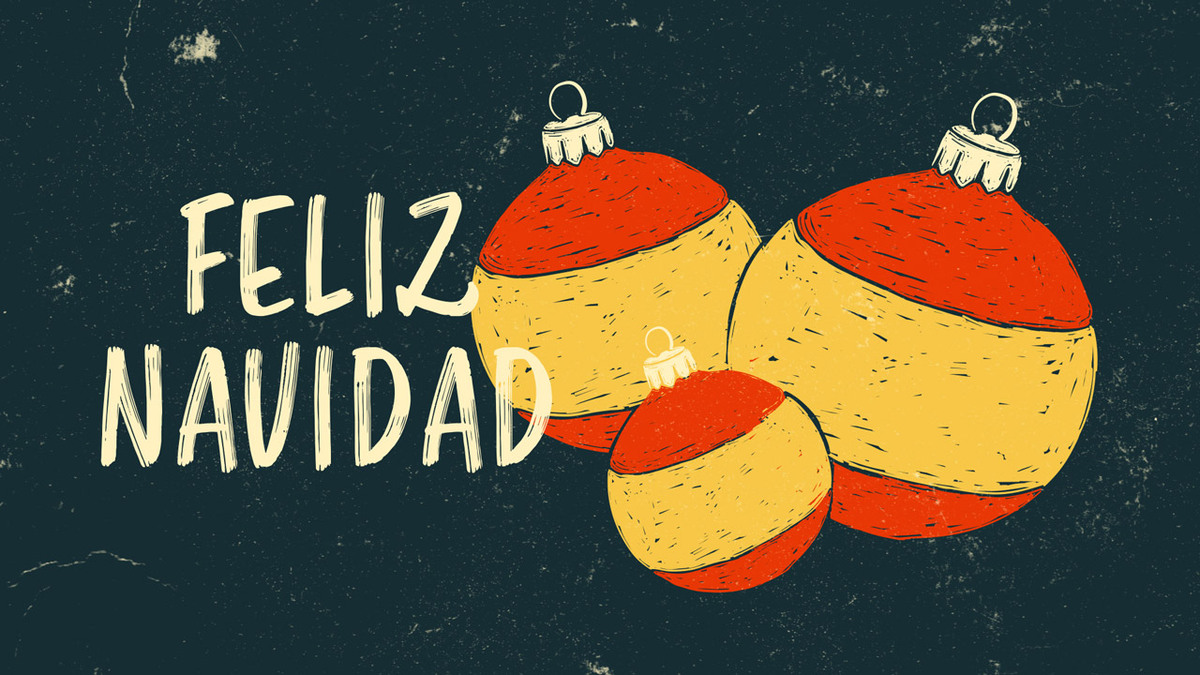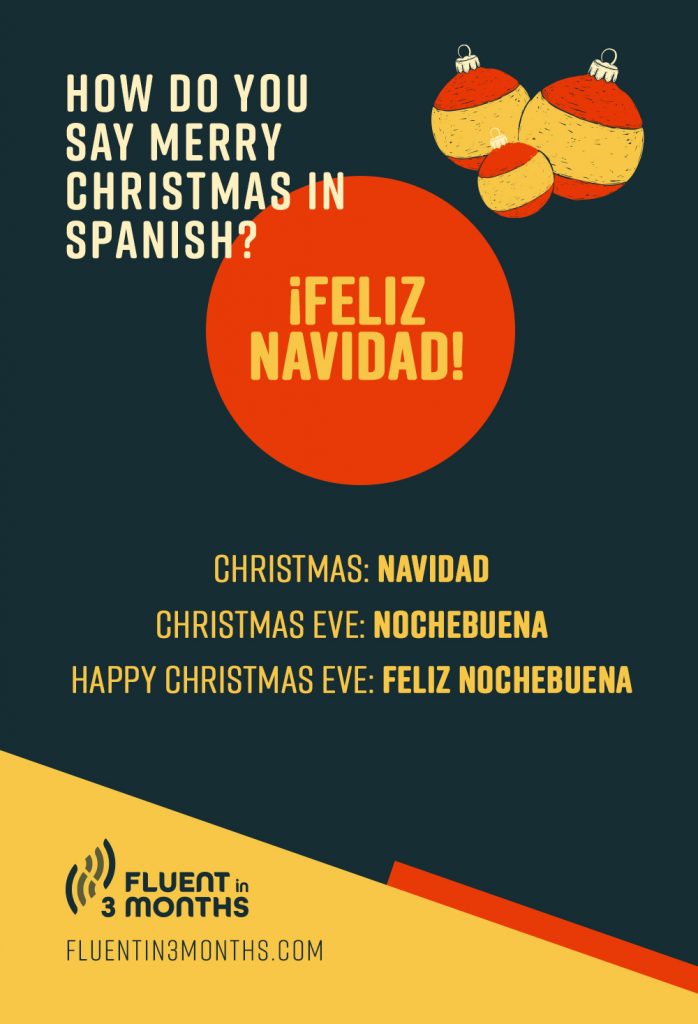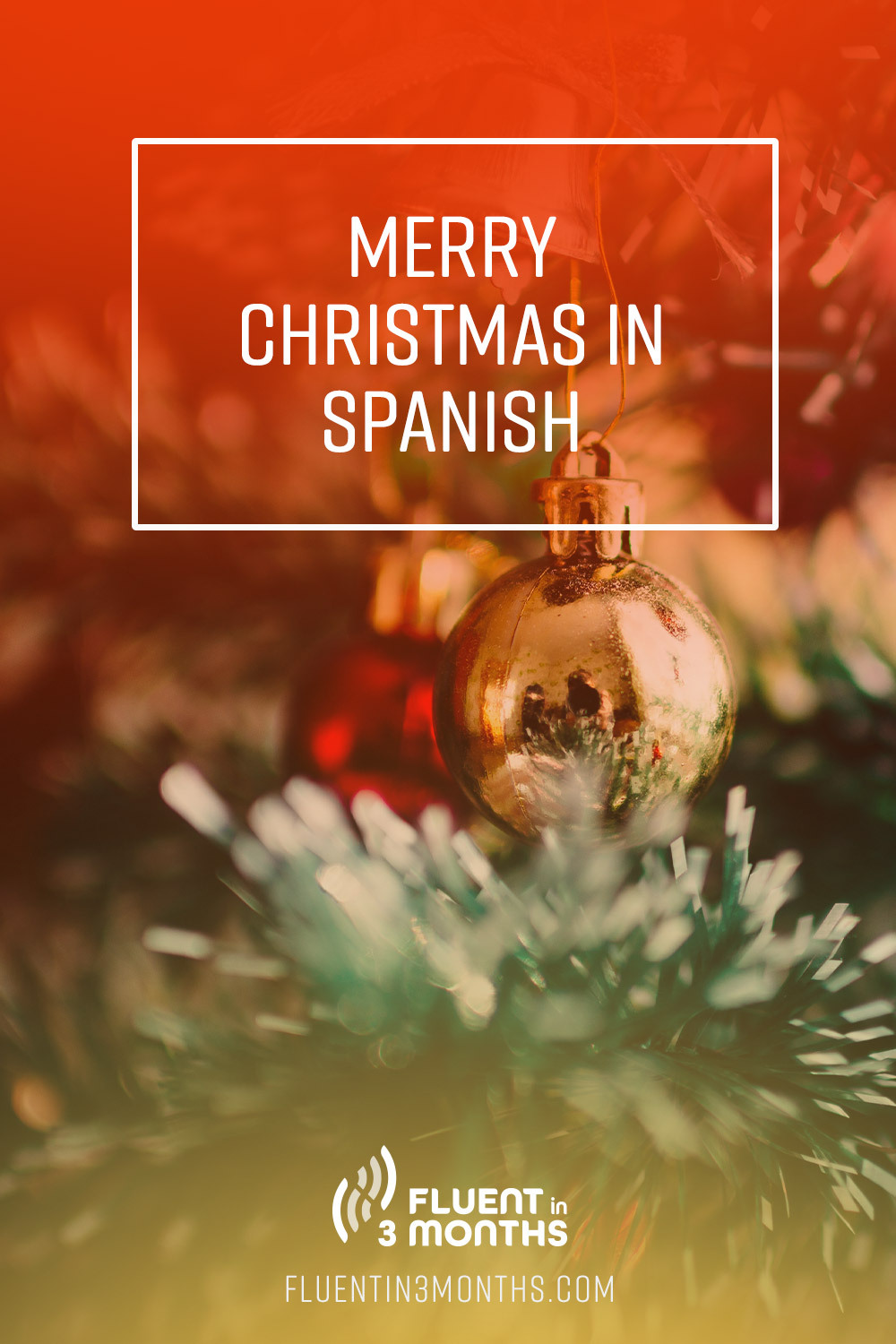Merry Christmas in Spanish: “Feliz Navidad” and More Spanish Holiday Vocab
How do you say “Christmas” in Spanish? How do they celebrate Christmas in Spanish-speaking cultures?
Here’s all the answers you ever wanted to know about the holidays in Spanish!
Besides Christmas Day itself, there are other holidays celebrated in Spanish-speaking countries over the winter. Some of these are even bigger than Christmas Day, and overall the winter festivities last about a month. These other holidays often focus on holy feast days from 8th December to 6th January. That said, Christmas Day has become more popular to celebrate,
So besides learning about Christmas in Spanish and all the holiday vocabulary you need, let’s learn about the unique holiday traditions from around the Spanish-speaking world.
Felices vacaciones! (“Happy Holidays!”)
Table of contents
“Merry Christmas” in Spanish
How do you say “Merry Christmas” in Spanish?
¡Feliz Navidad!
In English, feliz translates as “happy” and navidad means “nativity”. So, it actually means “Happy Christmas” or “Happy Nativity”. You may recognize the phrase from the popular tune – Feliz Navidad.
How would you say “Happy Christmas Eve”?
In Spanish, “Christmas Eve” is Nochebuena, which means “the Good Night”. So you might have guessed it: “Happy Christmas Eve” is Feliz Nochebuena.
Nochebuena is the day most big celebrations happen in Spain, like the dinner feast with family and Midnight Mass. Families often stay up all night during Nochebuena celebrating together and opening gifts.
Fun fact: The traditional Christmas flower, the Poinsettia, is also called Flor de Nochebuena (“The flower of the Good Night”).
“Happy New Year” in Spanish
You can wish someone a “Happy New Year” by saying Feliz Año Nuevo. This is a literal translation, with feliz meaning “happy”, año meaning “year”, and nuevo meaning “new”. In Spanish, the adjective comes after the noun it describes, so it literally translates as “Happy Year New”.
But, you can also wish someone a “prosperous new year”. You can say ¡Feliz Navidad y Próspero Año Nuevo! to wish someone “Merry Christmas and Happy New Year” in Spanish.
A lot of New Year traditions welcome in prosperity for the new year, so Próspero Año Nuevo is commonly used.
For New Year’s Eve, you say Nochevieja. It actually translates as “old night”, because it’s the last day of the old year.
There are a lot of hispanic superstitions about starting the new year completely new and fresh. Many people make sure they’ve cleaned their homes, and wear all new clothes. This way, nothing from the old year comes with them into the new one.
Some people believe this is important to ward off bad luck.
50+ More Spanish Words and Phrases for the Christmas Season
So how do you talk about Christmas in Spanish? How do you tell someone to countdown to midnight, and talk about your New Year’s Resolution?
Here are all the words you need to talk about the holidays in Spanish.
Christmas Spanish Vocabulary
- To wish – Desear
- Angel – Ángel
- To decorate – Decorar
- Christmas tree – Árbol de Navidad
- Winter – Invierno
- Snow – Nieve
- Sleigh bells – Campanas de trineo
- Presents – Regalos
- Mistletoe – Muérdago
- Reindeer – Reno
- Santa Claus- Papá Noel
- Candy cane – Bastón de caramelo
- Christmas card – Tarjeta de Navidad
- Snowman – Muñeco de nieve
- Celebrate – Celebrar
- Dinner – Cena
- Chimney – Chimenea
- Eggnog – Ponche de huevo
- Candles – Velas
- Elf – Elfo
- Ornament – Adorno
- Family – Familia
- Star – Estrella
- Fireplace – Hogar
- Chestnuts – Castañas
- Carols – Villancicos
- Gingerbread man / Gingerbread house – Hombre de pan de jengibre / Casa de jengibre
- Holiday – Vacaciones
- Hot chocolate – Chocolate caliente
- Jolly – Alegre
- Christmas lights – Luces de Navidad
- Naughty – Travieso
- Nice – Agradable
- Goodwill – Buena voluntad
- Nutcracker – Cascanueces
- Stocking – Calcetín navideño
- Tinsel – Oropel
- Good tidings – Buenas nuevas
- Wrapping paper – Papel de regalo
- December 25 – Vienticinco de diciembre
New Year’s Spanish Vocabulary
- Twelve o’clock – Las doce
- Countdown – Cuenta regresiva
- New Year’s resolution – Propósito de año nuevo
- Balloons – Globos
- Confetti – Confeti
- Midnight – Medianoche
- Grapes – Uvas
- Champagne – Champán
- Fireworks – Fuegoes artificiales
- Midnight kiss – Beso de medianoche
- Clock – Reloj
- Ring in the New Year – Anillo en el año nuevo
- Calendar – Calendario
- Tradition – Tradicion
- January 1st – Primero de enero
If you want to learn more Spanish Vocabulary, check out this video on how to learn Spanish online:
Spanish Christmas and Winter Holiday Traditions
With all the vocab I’ve given you, you’re likely ready to talk about your own traditions and holidays in Spanish. So, let’s learn about Spanish cultural traditions and unique holidays.
There are silly Spanish traditions, religious Spanish feast days, and a day even bigger than Christmas in most Spanish-speaking countries. Maybe this year, you can try a Spanish tradition, too!
Tió de Nadal
This one might confuse tennis fans at first, but it has no ties to the iconic Rafael Nadal or his uncle and coach Tony.
Celebrated in Catalonia, Tió de Nadal means “Christmas Log”, but it’s also called Caga Tió – the “Pooping Log”.
A wood log is dressed up with a face, wooden legs, and a hat on the feast day of the Immaculate Conception on December 8th. Children have to keep the log warm by covering it with a blanket, and feeding it small pieces of food in the evening.
On Christmas, the family will hit the log with a stick and ask the log to poop out treats. If they took good care of the log, they’ll receive their reward – usually turrón, a sweet nougat dessert.
El Día de los Reyes Magos
Although Christmas is now a day of gift-giving, it wasn’t always this way. The traditional day of gift-giving is January 6th, when the Wise Men bring the gifts, and not Santa Claus.
Called El Día de los Reyes Magos (“the day of the Wizard Kings”), this holiday is based on the biblical story of the three Wise Men who visited Jesus shortly after he was born. When they saw him, they presented him with gifts of frankincense, myrrh, and gold.
On January 6th, there is usually a parade during which the Wise Men go through town and throw candy to young children. When the kids return home, they leave out their shoes, hoping for “the Kings” to fill them with presents. If the kids have been bad, they might receive lumps of coal instead of gifts.
It’s not so bad today, though. In the past, the “coal” was real, but nowadays it’s actually candy!
Dia de los Santos Inocentes
The Spanish version of April Fool’s Day, called Día de los Santos Inocentes (“Day of the Holy Innocents”), happens a few days after Christmas on December 28th. It’s a fun day of pranks and silliness, just like April 1st can be.
El Gordo
Right before Christmas on December 22nd, the Spanish National Lottery (called, El Gordo, “The Fat One”) goes on. It’s the biggest lottery draw in the world! It’s a huge event, and everyone gets very excited about how much money they could win.
Christmas Day Traditions in the Spanish Speaking World
Christianity is important to many Hispanic families. It’s tradition for a family to eat a big Christmas dinner on Christmas Eve, and then go to la Misa del Gallo, which means “Mass of the Rooster” or Midnight Mass.
Why a Rooster? It’s believed the night Jesus was born, a rooster crowed to mark the beginning of a “new day”, even though it was night time.
Beléns is the Spanish word for Bethlehem, but it represents the nativity scene. While most Spanish homes will have a small nativity scene, large and grand nativity scenes are set up in towns. They are often immersive, with farms and a whole marketplace accompanying the nativity scene in the stable.
A bit like trick-or-treating and caroling mixed together, kids go around singing Christmas carols for treats. It’s called pedir el aguinaldo (“ask for the Christmas treat” or “bonus”). Sometimes the kids receive money, and sometimes candy, for their singing. It’s a fun tradition to spread Christmas cheer!
Fun fact: The tradition sometimes gets pushed to the limit. In fact, in some countries it’s common for teenagers to pedir el aguinaldo… at three in the morning! Not sure if I would prefer that or waking up to a house covered in toilet paper after Halloween.
New Year’s Traditions in Spanish Cultures
Ringing in the New Year in Spanish-speaking cultures involves a lot of lucky rituals!
Let’s start with a famous Spanish one: when the clock strikes twelve, people will eat 12 green grapes, called las doce uvas de la suerte, and make a wish for each one they eat.
It’s important to eat all the grapes within the first couple of minutes (or even before the end of the first minute) of the New Year so your wishes come true.
In some areas, people also eat lentils right after midnight or for lunch the next day. Lentils are small and round like coins, so they bring in prosperity! But others prefer to hold real coins at midnight in hopes the New Year will be filled with wealth.
As in other cultures, it’s common to drink champagne at midnight. But usually, the champagne is flavored to bring a certain type of luck in the New Year. For instance, put strawberries in your champagne to attract love, or a gold ring to attract wealth.
You want to make sure to pull it out of the glass when you’re done, so it comes true.
Another common Spanish tradition is to wear yellow. Yellow is a lucky colour in Spain and other Hispanic countries, so it’s often worn on New Year’s Eve.
But, if you’re looking for love, you must wear red underwear given to you by someone else. Strange as it sounds, red underwear means luck in love in the New Year, but only if it was a gift.
And when the clock strikes midnight, stand on your right foot! This starts the year off “on the right foot” – literally – so you have a good year.
¡Feliz Navidad y Próspero Año Nuevo!
Now, go wish someone a Merry Christmas and Happy New Year in Spanish! Try talking about the new Spanish holidays you learned, too. Did you know about the “pooping log” or the three Wise Men who bring gifts instead of Santa Claus?
If you will test out some traditional hispanic ways to spread the Christmas cheer or bring some good luck into your New Year, share it with me on social media. Find me on Instagram (@irishpolyglot), TikTok (@irishpolyglot), and Twitter (@irishpolyglot), and tag away!
Wherever you are in the world, I hope you have a ¡Feliz Navidad y Próspero Año Nuevo!






Social